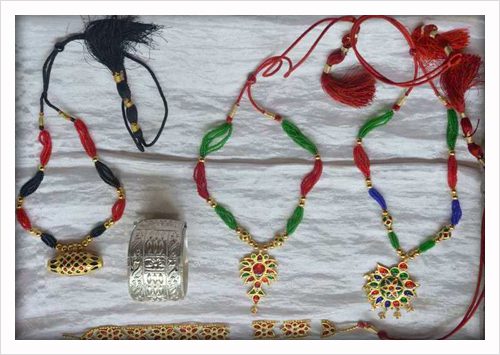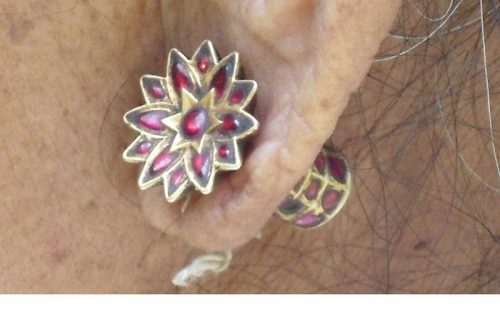Step into the world of legacy ornaments with these iconic Assam jewellery pieces. Crafted by skilled artisans who have honed their craft over generations, this jewellery is a true testament to the rich heritage of Assam.

Assamese ornaments hold a significant place in Assamese culture, often crafted from “Kesha Xoon,” or raw gold. These exquisite pieces of jewellery are not only visually stunning but also carry immense cultural prestige.
Typically handmade, Assam ornaments feature designs inspired by the region’s rich flora and fauna. The traditional pieces, while simple in design, are adorned with vibrant red gemstones, rubies, or mina work. The striking black, red, and green hues used in these gold ornaments beautifully complement the traditional attire of the tribes and communities of the northeastern states. Historically, these pieces were studded with gemstones like rubies, moonstones, emeralds, and garnets, earning them the local name “Dalimiya Pathur,” a reference to the pomegranate seed-like colour of the stones.
The creation of traditional Assamese jewellery is an intricate craft that requires specialized skills, with designs often reflecting elements of nature, musical instruments, or everyday life. These unique designs, crafted exclusively by skilled Assamese artisans, are a hallmark of the region’s jewellery. While gold remains the primary metal used, silver and other metals have also been employed for centuries.
This art form thrives particularly in three regions of Assam: Nagaon, Jorhat, and Barpeta. Jewellery from Upper Assam is predominantly stone-studded, whereas, in Lower Assam, the focus is on intricate gold designs with minimal or no stone embellishments.
Assamese jewellery pieces are often named after the design motifs they represent, such as Jon Biri (crescent-shaped pendant), Lokaparo (two pigeons placed back to back), Jethi Poti (featuring a lizard’s tail design with a row of small V-shaped medallions and a central pendant), and Dhol Biri (drum-shaped design), among others.
Iconic Jewellery Pieces of Assam
Japi
Japi is a traditional headgear of Assam, intricately crafted from bamboo and cane, symbolizing respect, dignity, and the rich cultural heritage of the region. Historically worn by farmers as protection from the sun, the Japi has evolved into a significant cultural icon.

Though not a conventional piece of jewellery, its ornamental versions, often embellished with vibrant designs and motifs, are worn by women during festivals and cultural events as a statement of cultural pride. The Japi not only reflects the craftsmanship of Assamese artisans but also serves as a symbol of the region’s identity, embodying the values of honour and tradition.
Gamkharu
Gamkharu is a traditional Assamese bangle crafted from gold or silver, renowned for its thick, solid structure and intricate designs. Often adorned with delicate engravings or minimalistic patterns, this bangle is a significant cultural symbol in Assam. Gamkharu is traditionally worn by married women, signifying their marital status, and is an essential element in Assamese weddings.

It is usually presented to the bride by her family or in-laws as a symbol of prosperity, commitment, and the bond of marriage. The bangle holds deep cultural value, representing the rich heritage of Assam and the enduring traditions that are passed down through generations.
Loka Paro
These earrings are often crafted in gold or silver, intricately designed to capture the delicate form of pigeons in mid-flight. Worn by Assamese women, Loka Paro holds deep cultural significance, symbolizing peace and harmony. The pigeon, as a universal symbol of tranquillity, is embodied in this jewellery, making it not just an adornment but also a representation of the values and aspirations of the Assamese people. Loka Paro earrings are cherished for their elegance and the cultural message they convey, making them a meaningful part of Assamese heritage.
Jonbiri and Doogdoogi
Jonbiri is a traditional Assamese necklace characterized by its striking crescent shape, often crafted from silver or gold. This elegant piece is typically paired with the Doogdoogi, a pendant that complements the Jonbiri with its intricate design and symbolic significance.
Together, Jonbiri and Doogdoogi are more than just adornments; they represent the cultural richness of Assam and are often worn during important cultural events and festivals. These jewellery pieces hold deep sentimental value and are frequently passed down through generations as cherished heirlooms, symbolizing the continuity of tradition and the enduring connection to Assamese heritage.
Keru
An ear ornament, traditionally worn by Assamese brides, the Keru is often crafted from gold or silver, featuring elaborate designs that showcase the craftsmanship of Assamese jewellers. This ear ornament is not only a symbol of marital status but also plays a crucial role in enhancing the beauty of the bride on her wedding day.

The delicate and ornate structure of the Keru complements the bridal attire, adding an element of elegance and cultural richness to the overall look. Beyond its aesthetic appeal, the Keru is deeply embedded in Assamese customs, symbolizing the bride’s connection to her heritage and the cultural traditions that are honoured and celebrated during the wedding ceremony.
Galpata
Galpata is a traditional Assamese necklace known for its intricate floral patterns, often crafted in gold or silver. This elegant piece of jewellery is typically worn by women during special occasions such as weddings, festivals, and cultural celebrations. The floral motifs of the Galpata symbolize femininity and grace, reflecting the delicate beauty and cultural sophistication of Assamese craftsmanship. Beyond its aesthetic appeal, the Galpata holds deep cultural significance, embodying the essence of womanhood in Assamese society and serving as a timeless expression of elegance and tradition.
Thuriya
The Thuriya is a traditional Assamese jewellery piece, characterized by its unique and intricate spiral design. Typically crafted from gold or silver, the Thuriya earrings are distinguished by their helix-like structure that coils gracefully, often ending in a small, rounded ornament.
These earrings hold cultural significance in Assam and are traditionally worn by women, especially during festivals and significant cultural ceremonies. The design of the Thuriya is both aesthetically pleasing and symbolic, often representing continuity and eternity.
Senpati
Senpati is a typical Assam traditional jewellery necklace known for its exquisite craftsmanship and cultural significance. Typically made of gold, the Senpati necklace features intricate designs, often inspired by nature, such as floral and leaf motifs. This necklace is a symbol of Assamese heritage and is commonly worn by brides as part of their wedding attire, signifying prosperity and tradition.
Dhansiri
Dhansiri is a traditional Assamese necklace named after the Dhansiri River, a significant waterway in Assam known for its natural beauty and cultural importance. This necklace symbolizes prosperity and abundance, reflecting the fertile lands nourished by the river.
Typically crafted from gold, the Dhansiri necklace features intricate designs that often incorporate motifs inspired by the river and its surroundings, such as flowing water patterns, leaves, and other natural elements. The necklace is cherished for its cultural significance and is often worn during important festivals, weddings, and other ceremonial occasions in Assam.
Magardana
Known for its intricate design, the Magardana often features motifs inspired by nature, such as flowers, leaves, or animals, with the most common being floral patterns. This piece of jewellery is usually made from gold and is often adorned with delicate engravings or embossing, showcasing the exquisite craftsmanship of Assamese artisans.
Magardana rings are not only decorative but also hold cultural significance, often worn during special occasions like weddings and festivals. They symbolize prosperity and are sometimes passed down as heirlooms within families.
Uka-keru
Uka-keru is a traditional earring from Assam, known for its simple and elegant design. Unlike the more ornate Assamese earrings like Loka-paro or Thuriya, Uka-keru is typically crafted from gold or silver with a minimalist approach, often featuring a plain hoop or a modest decorative element.
These earrings are a staple in everyday wear for Assamese women, embodying both practicality and subtle beauty. Though not as elaborate as other traditional pieces, Uka-keru holds cultural value, symbolizing the grace and tradition inherent in Assamese jewellery.
Kerumoni
Typically crafted from gold, Kerumoni earrings are small and often feature detailed floral or geometric patterns, reflecting the skilled craftsmanship of Assamese artisans. These earrings are commonly worn by women across Assam, particularly by young girls, and are a staple in traditional Assamese attire. The name “Kerumoni” combines “Karu” (meaning small) and “Moni” (meaning jewel or gem), emphasizing the earring’s petite and elegant nature.
The Role of Jewellery in Assamese Festivals and Rituals
Jewellery plays a crucial role in Assamese festivals, weddings, and cultural ceremonies, serving not only as adornment but also as a symbol of the region’s rich traditions and heritage. During festivals like Bihu, the most important festival in Assam, traditional jewellery such as Gamkharu (heavy gold bangles), Kerumoni (small, intricate earrings), and Thuriya (spiral earrings) are worn by women to celebrate the occasion with elegance and cultural pride.
These pieces are not merely decorative; they carry deep symbolic meanings that are intertwined with Assamese customs. For example, Gamkharu is often worn to signify strength and prosperity, while Thuriya represents continuity and the cyclical nature of life, echoing the rhythms of the agricultural cycles celebrated during Bihu.
Beyond their aesthetic appeal, these jewellery pieces are imbued with cultural and spiritual significance, often passed down through generations as family heirlooms, thus preserving the state’s cultural legacy. During religious rituals and other cultural ceremonies, wearing traditional jewellery is a way of honouring the gods and ancestors, as well as a demonstration of respect for Assamese customs.
The craftsmanship involved in these pieces reflects the region’s artistic heritage, with each design carrying stories and symbolism that connect the wearer to Assam’s rich cultural tapestry. In essence, traditional Assamese jewellery is not just an accessory; it is a living expression of the state’s identity, history, and values, playing a vital role in the celebration and preservation of Assamese culture.
FAQs About Assamese Traditional Jewellery
- What materials are used to make Assamese traditional jewellery?
Assamese traditional jewellery can be crafted from pure gold (24 carats), silver with gold leaf work, silver with gold polish, or even plain silver. The foundation for all these pieces is a natural resin called ‘lac,’ extracted from trees. Mina work is often added, with red and green being the most common colours. - Where is traditional Assamese jewellery produced?
The village of Ranthali in the Nagaon district, about 8 km from the main town of Nagaon, is renowned for producing traditional Assamese jewellery. Jewellery making is the primary occupation of the villagers in this area. - What is the historical significance of Assam jewellery?
The history of Assamese traditional jewellery dates back to medieval India, during the era of the Ahom Kingdom, which ruled Assam for 600 years from 1228 to 1826. In those royal times, jewellery was crafted from various metals such as gold, silver, copper, and brass, as well as materials like amber, rhinoceros horns, ivory, and precious gems including pearls, rubies, and diamonds.
Read more: Latest



